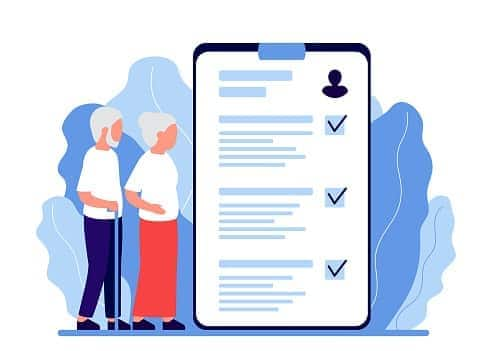- What does disability insurance cover?
- Types of disability insurance
- Who needs disability insurance?
- How much does disability insurance cost?
- Do I need more coverage if I have disability insurance through my job?
- Do I need an individual policy if I can get coverage through Social Security?
- How much disability insurance do I need?
- When does my disability insurance start?
- Disability insurance terms to know
- Is disability insurance right for me?
What does disability insurance cover?
Disability insurance will cover part of your salary if you become disabled. Those contributions end when you return to your job.
The protection pays out a percentage of your salary.
You can get disability insurance plans in three ways:
- Individual policies that you purchase on your own.
- Group plans that you purchase through an employer or organization.
- Employer-sponsored group coverage that your employer pays all or part of the premiums.
Each of the plans has benefits and drawbacks. The plans typically replace 40 to 60% of your income. They frequently have income caps. You might only get reimbursed a limited amount. You'll want to check about income caps and reimbursement limits on your plans when get disabilty insurance quotes from companies. If you're a higher earner, you might exceed the cap. It's a smart idea to explore supplemental disability insurance to help provide extra funding if you become disabled.
A benefit of individual disability insurance is you take it with you when you leave your job. That's not the case with employer-based plans.
Group plans, including ones through professional organizations, are usually cheaper than individual policies. That’s because you're buying a policy with a group of other people. Also, you won't get denied for group coverage. That's unlike individual coverage. With an individual plan, a disability insurance company reviews your factors, such as age, sex, job and salary potential. Group coverage won't dig into that information.
However, since the group plan is connected to an organization or employer, you will lose it if you leave your job or organization.
Employers, especially large companies, may offer both short-term disability and long-term disability options. Short-term will pay you a percentage of your income for a few months. Long-term often pays 40 to 60% of your base salary for a longer time. Your employer may offer a chance to build on that coverage to give you more funding if you become disabled.
In addition to these plans, you may get help from the government through workers' compensation or a state disability insurance program depending on your injury. It's important to remember though that the vast majority of disability claims have nothing to do with on-the-job injuries. The National Safety Council estimates that 73% of long-term disabilities aren't work-related so you won't qualify for workers' compensation.
Types of disability insurance
There are two types of disability insurance:
- Short-term disability insurance typically covers you for three months.
- Long-term disability insurance kicks in after the short-term period ends. Long-term disability usually lasts two, five or 10 years or until the age of 65 or 67, depending on the policy.
If you buy your own policy, the insurance generally replaces 40 to 60% of your income. Employer policies typically pay about 60% of your income.
If you become disabled, a doctor will examine you and determine if your disability prevents you from working. You get paid once that determination is made in your favor.
Who needs disability insurance?
Anyone with a job should consider disability insurance. You never know when an injury or ailment will take away your income temporarily. You may break a hand and can’t type. You might get pneumonia and not work for a month.
Life Happens, a nonprofit consumer group, said you have a 30% chance of having an illness or injury that keeps you out of work for 90 days or longer. In most cases, the disability isn’t work-related, so you won’t be able to collect workers’ compensation.
That’s when disability insurance can help you and make sure you pay your regular payments. The last thing you want is to miss work, forfeit payments and wind up past due on your credit cards and mortgage.
How much does disability insurance cost?
Disability insurance cost is linked to your age and health. Younger, healthier people pay less, so, in that way, it’s similar to life insurance.
The three types of disability insurance plans vary significantly by rates. Insurers base individual rates on your age, sex, job, and salary potential:
- An individual policy may cost between 1 and 3% of your annual income.
- Group policies cost about 1%.
- Employer-sponsored plans are usually the most affordable and cost about 0.5%, but they are taxed.
Income also plays a role. Someone who makes a lower salary will pay less in premiums than a person with a higher income. The insurer would pay out less if you have a lower income, so they charge lower premiums.
A healthy 25-year-old earning $30,000 a year might pay $20 to $25 a month for coverage. Meanwhile, a 55-year-old with health issues making $120,000 annually might pay $100 per month or more.
Also, an insurer may reject a person with major health problems or it may charge huge premiums.
Keep all of that in mind when you're getting disability insurance quotes.
Do I need more coverage if I have disability insurance through my job?
Financial advisers generally recommend buying individual disability insurance to go along with an at-work plan. Your employer's coverage may not be enough to protect you fully. They note that work plans typically pay 60% of your salary. However, you'll have to pay tax on those insurance benefits.
Also, the income amount from the at-work policy is usually capped at $5,000 a month. That amount may be less than 60% of your income if you’re a high-earner. And keep in mind that the 60% typically applies to base salary only. What about bonuses and commissions? Well, they usually don't figure in the equation, which could be a significant problem for employees who depend on those money sources.
Experts further point out that group policies often only cover catastrophic events. However, about 90% of disability claims come from illness.
Also, you could lose your current at-work coverage if you change jobs. This could be a problem if your next job doesn't provide disability insurance.
Do I need an individual policy if I can get coverage through Social Security?
Social Security disability protection is usually available for those judged by the SSA to be totally disabled. Qualifying can be difficult. You'll have to get proof from a doctor.
The average payout in 2020 is about $1,258 a month, which is less than many people's monthly expenses.
How much disability insurance do I need?
Start by figuring out annual income. Disability insurance is meant to keep enough flowing into your household if you're disabled and unable to work. It's important to examine your income and determine how much you will need.
Take into account:
- Regular income
- Mortgage
- Retirement
- Future living expenses
- Children's education expenses
One way to figure out how much you may need is to plug your information into the Life Happens calculator. The tool estimates what income you will need to maintain your standard of living if you become disabled.
Here’s what to do once you figure out how much you can get from disability insurance. Combine that amount to your partner's salary to see if you would have enough to survive and plan for the future in the event you become disabled and can't work.
If you find you won't have enough between your spouse and your disability plan, experts suggest you and your partner may want to purchase individual disability insurance policies.
When does my disability insurance start?
Insurance companies have different policies as to when plans begin to pay disability payments. Even the best disability insurance companies vary.
Disability coverage has a grace period called the "elimination period.” That is the period immediately after you become disabled. The insurance company doesn't begin paying you until the elimination period is over. This period is typically 90 days but ranges from one month to a year depending on the policy. You'll want to know this before signing up with an insurer.
The benefit of going with a longer elimination period is that the policies are cheaper. That might work for you if you have a large nest egg you can tap into before the elimination period ends. If you live paycheck-to-paycheck or don't have much savings, you will likely want to pay a higher premium. That way, you know you'll have to wait a shorter time before the insurer starts paying you.
Disability insurance terms to know
Disability insurance has many terms that you might not understand. That can make choosing the best disability insurance policy difficult. Let’s take a look at phrases and what they mean so that you can make the best decision:
- Partial or total disability coverage. You can go with a policy that only kicks in if you're totally disabled or one that allows you to collect partial payment if you're partially disabled and can only work part-time.
- Elimination period. This is the length of time -- usually 30, 60 or 90 days -- you'll need to be out of work before collecting a payment. Be aware that a policy with a shorter elimination period costs more.
- Benefit period. This is how long you can collect benefits. You decide -- it could be for two years, five years, until age 65, until retirement age or for another period.
- Occupational class. The cost of coverage, in part, depends on your job. If you have a white-collar position, you'll likely pay less than a blue-collar worker who may face more risks on the job.
- Own occupation vs. any occupation. You can get coverage that takes effect if you can't do your particular profession or a policy that covers you if you can't perform any occupation. Someone like a neurosurgeon might opt for coverage for his or her own profession. The coverage is more expensive. Coverage for "any occupation" means you can't perform any job for which you have the education and training.
- Inflation protection. A cost-of-living policy rider will increase benefits to keep pace with inflation if you become disabled. For instance, let’s talk about a 30-year-old who becomes permanently disabled and unable to work. Inflation would erode the value of your benefits by the time that person reached middle age. This rider is recommended for younger people and tends to add 15 to 25% to the cost of a policy. If you're nearing retirement, experts say the extra cost probably isn't worth it.
- Waiver of premium. This feature allows you to not pay premiums while you are disabled and collecting benefits.
- Extra coverage for severe disability. In addition to paying a percentage of your salary, a policy with a catastrophic rider pays additional money if you're unable to perform two out of six "activities of daily living" or have a cognitive impairment. The six activities are eating, bathing, dressing, toileting, continence and transferring (such as moving from a wheelchair to bed). This rider tends to increase a policy's cost by about 10%.
- Retirement savings protection. This replaces the retirement savings contributions while you can't work. The Guardian's Retirement Protection Plus rider, for instance, pays 100% of what you normally set aside for retirement, as well as any employer matching contributions, into a trust. A trustee invests the benefits at your direction.
Health insurance finder tool




COBRA
Learn more about COBRA


Medicare
Medicare costs vary depending on which option you choose.
Learn more about Medicare costs.


Medicaid


Parent's employer-sponsored health insurance

Spouse's employer-sponsored health insurance

- PPO
- HMO
- HDHP
- EPO
Employer-sponsored health insurance

- PPO
- HMO
- HDHP
- EPO
- PPO
- HMO
- HDHP
- EPO
Preferred-provider Organization (PPOs)
- Pay higher premiums with a lower deductible
- You have access to more providers, but pay much more for health insurance
- You don't want to choose a primary care physician
- You don't want to get a referral
- You want the ability to get out-of-network care
Find out more about the differences between plans
Health maintenance organization (HMO)
- Pay higher premiums with a lower deductible
- Restricted network of providers with lower premiums
- You want to choose a primary care physician
- You don't mind getting a referral
- You don't care about the ability to get out-of-network care
Find out more about the differences between plans
High-deductible health plans (HDHPs)
- Pay lower premiums with a higher deductible
Find out more about the differences between plans
Exclusive provider organization (EPO)
- Restricted network of providers with lower premiums
- You don't want to choose a primary care physician
- You don't want to get a referral
- You don't care about the ability to get out-of-network care
Find out more about the differences between plans


Learn more about individual insurance plans

Is disability insurance right for me?
Your type of job likely won't influence whether you need disability insurance. Most disability insurance claims come because of non-work-related injuries and illnesses.
If you decide to pursue disability insurance, you want to check with your employer to explore its offerings. Also, check with your organizations to see what they provide. Remember, with these types of plans, you lose coverage if you leave the employer or group.
You'll also want to check into individual plans. The benefits of individual plans are that they belong to you, so you can take it with you when you leave your job.
Regardless of what avenue you take, it's always a great idea to shop around to find the disability insurance plan that's right for you and your situation.
Mark Chalon Smith contributed to the article.







